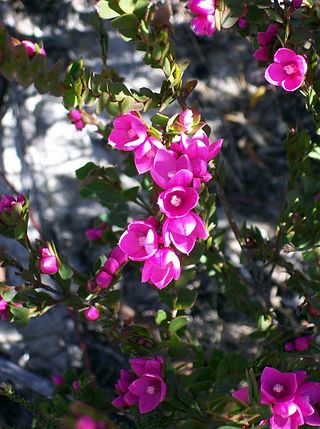
Boronia serrulata, commonly known as native rose or rose boronia, is a species of plant in the citrus family, Rutaceae, and is endemic to New South Wales, mainly in the Sydney basin. It is an erect, woody shrub with glabrous branchlets, simple, egg-shaped leaves with fine teeth on the edges, and bright pink, four-petalled flowers on the ends of the branchlets.

Boronia molloyae, commonly called the tall boronia, is a plant in the citrus family that is endemic to coastal regions in the south-west of Western Australia. It is a shrub with pinnate leaves that mostly have between three and seven leaflets, and deep rose pink, four-petalled flowers. It usually grows along streams in sandy soil.

Boronia mollis, commonly known as soft boronia, is a plant in the citrus family and is endemic to New South Wales. It is a shrub with pinnate leaves, and small groups of pink flowers in leaf axils. It grows in coastal areas in forest.

Verticordia lindleyi is a flowering plant in the myrtle family, Myrtaceae and is endemic to the south-west of Western Australia. It is sometimes an openly branched shrub, other times more or less dense, with small leaves and spreading, spike-like groups of pink or purple flowers along the stems in summer, sometimes also in autumn.

Boronia crenulata, commonly known as aniseed boronia, is a plant in the citrus family Rutaceae and is endemic to the south-west of Western Australia. It is an open-branched shrub, often trailing between other plants, has strap-like leaves and pink to purple-red, four-petalled flowers in winter and autumn.

Boronia albiflora is a plant in the citrus family, Rutaceae and is endemic to the south-west of Western Australia. It is a soft shrub with pinnate leaves and pink or pink and white, four-petalled flowers.

Boronia barkeriana, commonly known as Barker's boronia, is a plant in the citrus family, Rutaceae and is endemic to eastern Australia. It is a shrub with ground-hugging branches, simple, toothed leaves and bright pink, four-petalled flowers.

Cyanothamnus coerulescens, commonly known as blue boronia, is a plant in the citrus family, Rutaceae and is endemic to southern Australia. It is a small, spindly shrub with glandular stems, small, more or less cylindrical leaves and blue to pinkish mauve, four-petalled flowers. There are two subspecies endemic to Western Australia and a third that also occurs in three eastern states.
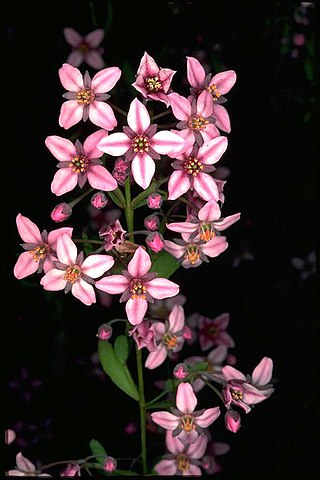
Boronia fastigiata, commonly known as bushy boronia, is a plant in the citrus family, Rutaceae and is endemic to the south-west of Western Australia. It is an erect shrub with small leaves and small groups of red, pink or purple, four-petalled flowers near the ends of the branches.

Boronia anceps is a plant in the citrus family, Rutaceae and is endemic to a small area in the south-west of Western Australia. It is a perennial herb with small leaves and pink, four-petalled flowers.

Boronia dichotoma is a plant in the citrus family, Rutaceae and is endemic to the south-west of Western Australia. It is an erect, slender perennial herb or shrub with simple leaves and pink, four-petalled flowers. The species is characterised by sticky glandular hairs on the pedicels.

Boronia hapalophylla is a plant in the citrus family Rutaceae and is endemic to New South Wales. It is an erect or straggling shrub with simple leaves, hairy branches and relatively large pink, four-petalled flowers.
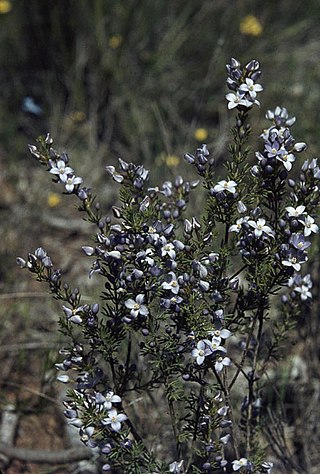
Cyanothamnus ramosus is a species of plant in the citrus family Rutaceae and is endemic to the southwest of Western Australia. It is an erect, mostly glabrous shrub with pinnate leaves with up to seven leaflets, and white, four-petalled flowers with blue or pale green backs.

Boronia revoluta, commonly known as Ironcap boronia, is a plant in the citrus family, Rutaceae and is endemic to the south-west of Western Australia. It is an erect shrub with three-part leaves and pink or white, four-petalled flowers.
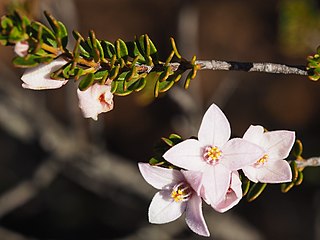
Boronia scabra, commonly known as rough boronia, is a plant in the citrus family, Rutaceae and is endemic to the south-west of Western Australia. It is an open shrub with simple, often clustered, oblong to elliptic leaves, and pink, mostly four-petalled flowers.

Boronia spathulata is a plant in the citrus family, Rutaceae and is endemic to the south-west of Western Australia. It is a glabrous shrub with well-spaced, simple, egg-shaped to elliptic leaves, and pink, four-petalled flowers.

Boronia stricta is a plant in the citrus family, Rutaceae and is endemic to near-coastal areas of the south-west of Western Australia. It is a slender shrub with often crowded pinnate leaves with linear leaflets, and pink, four-petalled flowers borne singly or in groups of two or three in leaf axils.

Boronia tenuior is a species of flowering plant that is endemic to Western Australia. It is an open shrub with thin, square stems, simple, serrated leaves, and pink to mauve, four-petalled flowers.
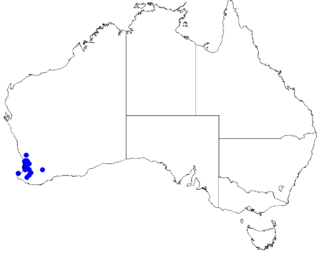
Cyanothamnus tenuis, commonly known as blue boronia, is a species of plant in the citrus family, Rutaceae, and is endemic to the southwest of Western Australia. It is a slender shrub with thread-like, sessile leaves, and flowers with four petals that are white to pink on the front and pale blue on the back.

Bossiaea disticha is a species of flowering plant in the family Fabaceae and is endemic to the far southwest of Western Australia. It is a weak, slender shrub with oblong to egg-shaped leaves and bright yellow and red flowers.





















